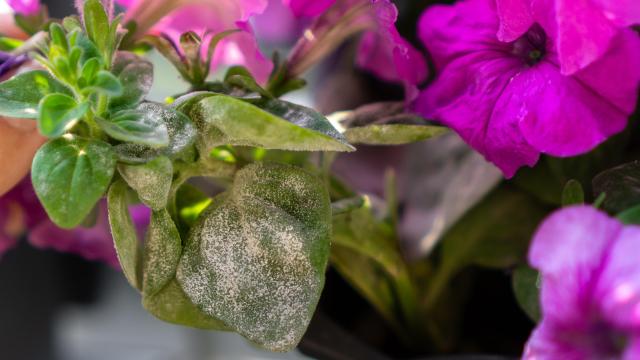One of the best parts about having a garden in the summer is watching your plants grow throughout the season. But if you’re out gazing at your garden one day and notice some white circular spots on the leaves, or that they look like they’ve been dusted with flour, you may be dealing with powdery mildew.
Powdery mildew really isn’t something you want to mess with, because not only can it harm the plant its on, but it can spread to others in your garden and infect them too. Here’s what to know about powdery mildew and how to get rid of it.
What is powdery mildew?
Powdery mildew is a fungal disease that makes it look like plants have been dusted with flour or baby powder. The white powder starts out in circular spots, then eventually spreads to cover the entire leaf — sometimes, including the bottom part of the leaf. The powdery mildew can cause the leaves and buds to become disfigured, twist, break, or turn yellow and dry out.
How to prevent the spread of powdery mildew
The key to getting rid of powdery mildew is to do it as soon as you see it. Unfortunately, once the fungus takes hold of a plant and makes itself at home in its leaves, there’s not much you can do to save that plant. That being said, you can (and should) do what you can to prevent it from spreading to other plants in your garden.
According to the Farmers’ Almanac, the way to do that is by removing all the infected leaves, stems, and fruits from a plant and then either throwing them away in the garbage, or burning them. Don’t just throw the clippings in the woods or on a compost pile, because that can allow the fungus to continue to spread. And then once you’re finished pruning, take the time to sterilise your shears with rubbing alcohol so you don’t infect any other plants.
How to get rid of powdery mildew
As we mentioned, the most important part is catching powdery mildew early on, so you have the best chance of getting rid of it. Here are a few methods, courtesy of the Farmers’ Almanac:
Spray the plants with water
The mildew spores can’t tolerate rain or water because they’re not able to germinate or grow if the leaves of a plant are wet. So spraying your plants with water at least once a week (which you may be doing anyway), can help keep powdery mildew at bay.
DIY sprays
Many seasoned gardeners have their favourite DIY concoctions for getting rid of powdery mildew. Because several contain ingredients like vinegar and baking soda that can burn your plants, test the sprays in a small area first before covering your whole garden with it. A few include:
- 1 tablespoon baking soda + 1 tablespoon vegetable oil + 1 teaspoon dish soap + 4 l of water
- 4 tablespoons baking soda + 2 tablespoons of Murphy’s oil soap + 4 l of water
- 2 to 3 tablespoons vinegar + 4 l of water
- 1 part milk to 10 parts water
- 1 cup mouthwash + 3 cups of water
Neem oil
Neem oil is an organic fungicide that you can either purchase on its own and mix with water according to the directions, or in a pre-mixed spray. Follow the instructions on the label to rid your garden of powdery mildew.

Leave a Reply
You must be logged in to post a comment.